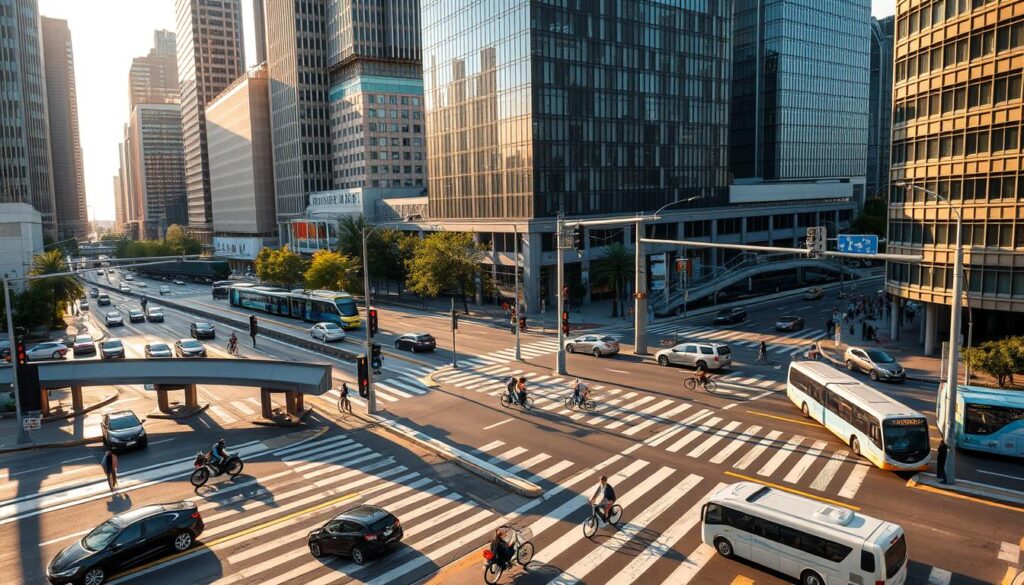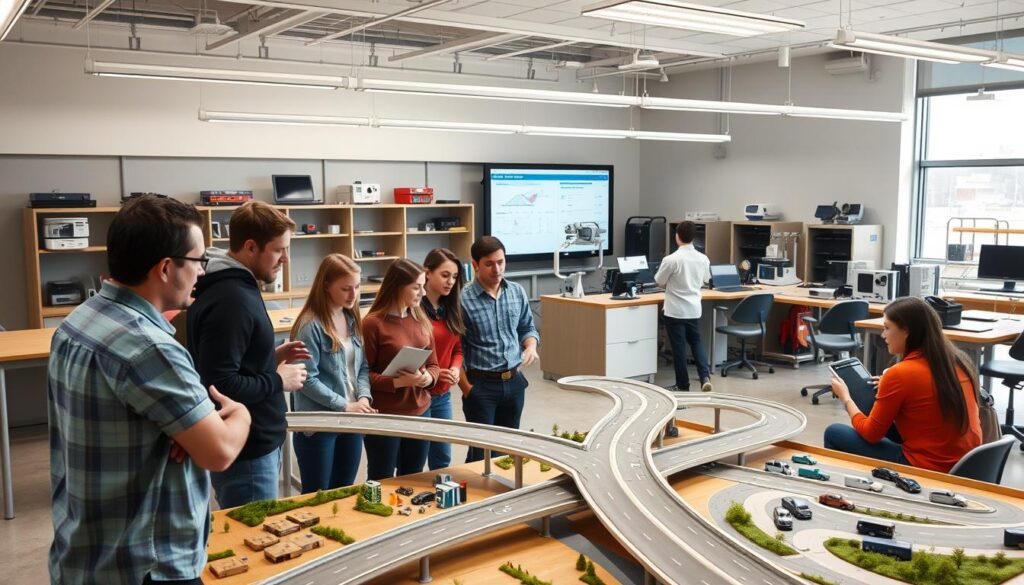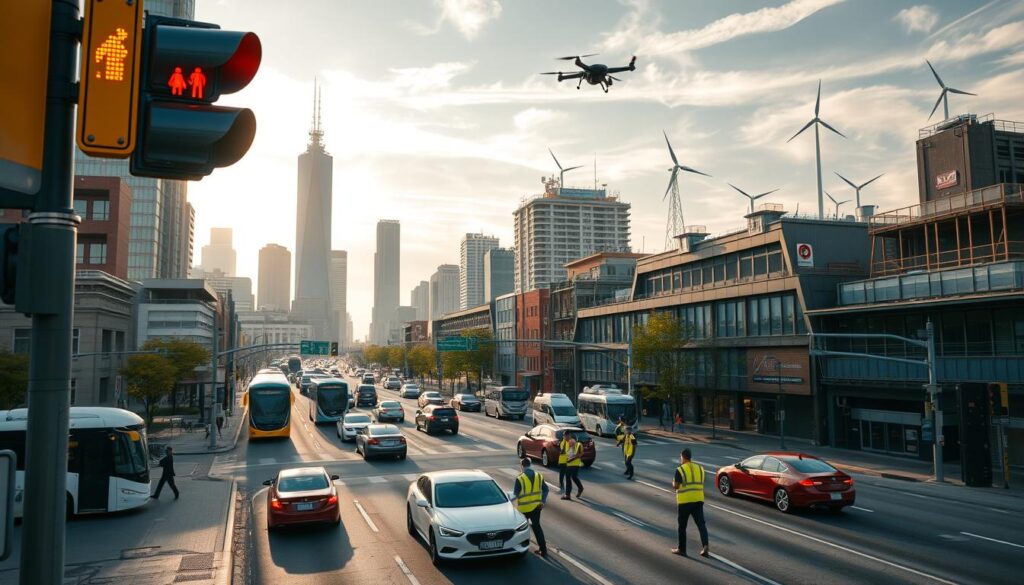Have you ever wondered who designs the roads, highways, and public transportation systems that keep our cities moving? Transportation engineers play a crucial role in shaping our transportation infrastructure.
These professionals are responsible for designing, building, and maintaining the complex networks that enable us to travel safely and efficiently. Their work involves a deep understanding of traffic patterns, urban planning, and environmental impact.
By combining technical expertise with creative problem-solving, transportation engineers help to reduce congestion, improve safety, and promote sustainable transportation solutions.
Key Takeaways
- Transportation engineers design and maintain transportation infrastructure.
- Their work involves understanding traffic patterns and urban planning.
- They play a crucial role in reducing congestion and improving safety.
- Transportation engineers promote sustainable transportation solutions.
- Their work has a significant impact on the environment and public health.
Overview of Transportation Engineering
As a critical component of civil engineering, transportation engineering plays a key role in shaping the modern transportation landscape. It involves the application of engineering principles to design, build, and maintain transportation infrastructure, including roads, bridges, airports, and public transit systems.
Definition of Transportation Engineering
Transportation engineering is a specialized field within civil engineering that focuses on the planning, design, operation, and maintenance of transportation systems. It requires a deep understanding of engineering, mathematics, and social sciences to develop efficient and safe transportation solutions. Transportation engineers use their expertise to analyze traffic patterns, design road networks, and implement traffic management strategies.
Importance of Transportation Infrastructure
The importance of transportation infrastructure cannot be overstated. It is the backbone of a country’s economy, facilitating the movement of goods and people. Well-designed transportation systems can reduce congestion, improve safety, and enhance the quality of life for communities. Moreover, transportation infrastructure development is crucial for economic growth, as it connects markets, creates jobs, and stimulates investment.
Effective transportation engineering also considers environmental impacts, striving to minimize the ecological footprint of transportation projects. By adopting sustainable practices and innovative technologies, transportation engineers can help create a more environmentally friendly transportation network.
Roles and Responsibilities of Transportation Engineers
The duties of transportation engineers are diverse, ranging from planning to managing transportation infrastructure. Their work is crucial in ensuring that transportation systems are safe, efficient, and environmentally friendly.

Planning and Design of Transportation Systems
Transportation engineers are responsible for planning and designing transportation systems that meet the needs of communities. This involves analyzing data to determine the best routes and modes of transportation, as well as designing infrastructure such as roads, bridges, and public transit systems.
They use advanced software and technologies, including Geographic Information Systems (GIS) and traffic simulation tools, to model and analyze transportation systems. This helps in identifying potential issues and optimizing system performance.
Traffic Management and Safety Analysis
Another key responsibility is traffic management and safety analysis. Transportation engineers study traffic patterns to identify areas of congestion and potential safety hazards. They then develop strategies to mitigate these issues, such as improving traffic signal timing or redesigning intersections.
Safety analysis involves assessing the risk of accidents and implementing measures to reduce these risks. This can include designing safer road geometries, improving lighting, and enhancing pedestrian and cyclist infrastructure.
Environmental Impact Assessments
Transportation engineers must also conduct environmental impact assessments to evaluate the potential effects of transportation projects on the environment. This includes assessing impacts on air quality, water quality, and wildlife habitats.
By identifying potential environmental impacts early in the planning process, transportation engineers can develop strategies to mitigate these effects, such as incorporating green infrastructure or implementing measures to reduce noise pollution.
Types of Transportation Engineers
There are several types of transportation engineers, each with distinct responsibilities. These professionals work together to ensure the efficient and safe movement of people and goods.
Transportation engineers specialize in various areas, including highways, traffic management, public transit systems, and aviation. Each specialty requires a unique set of skills and knowledge.
Highway Engineers
Highway engineers focus on the design, construction, and maintenance of highways and roads. They are involved in road construction projects, ensuring that highways are safe and efficient.
- Designing highway alignments and interchanges
- Conducting traffic studies to determine highway capacity
- Overseeing the construction of new highways or the rehabilitation of existing ones
Traffic Engineers
Traffic engineers are responsible for analyzing and improving traffic flow. They use their knowledge of traffic management to reduce congestion and enhance safety.
- Analyzing traffic patterns to identify areas of congestion
- Designing traffic signals and intersections
- Implementing intelligent transportation systems (ITS) to optimize traffic flow
Transit Engineers
Transit engineers work on public transportation systems, including buses, trains, and subways. They focus on making transit systems more efficient and user-friendly.
- Designing transit routes and schedules
- Improving transit infrastructure, such as stations and depots
- Enhancing the passenger experience through technology and amenities
Aviation Engineers
Aviation engineers are involved in the design and operation of airports. They work on ensuring that airports are safe, efficient, and meet the needs of passengers and airlines.
- Designing airport layouts and infrastructure
- Overseeing the construction of new airport facilities
- Implementing safety measures and procedures
Education and Qualifications for Transportation Engineers
The path to a career in transportation engineering begins with the right education and professional certifications. Transportation engineers are responsible for designing and developing transportation systems, which requires a strong educational foundation in a relevant field.
Relevant Degree Programs
A bachelor’s degree in civil engineering or a related field is typically required for entry-level positions in transportation engineering. Coursework should include classes in transportation engineering, highway design, traffic engineering, and urban planning. Some colleges and universities offer specialized programs in transportation engineering or a civil engineering specialization that includes transportation engineering as a focus area.

Professional Licensure and Certifications
In the United States, professional engineers are required to be licensed. For transportation engineers, this typically involves obtaining a Professional Engineer (PE) license. The process involves graduating from an accredited program, passing the Fundamentals of Engineering (FE) exam, gaining relevant work experience, and then passing the Principles and Practice of Engineering (PE) exam. Additional certifications, such as those offered by the Institute of Transportation Engineers (ITE), can also be beneficial for career advancement.
| Certification | Description | Issuing Organization |
|---|---|---|
| Professional Engineer (PE) | Licensure for professional engineers | State Licensing Boards |
| Institute of Transportation Engineers (ITE) Certification | Certification for transportation engineers | Institute of Transportation Engineers |
| Certified Traffic Control Designer (CTCD) | Certification for traffic control designers | National Committee on Uniform Traffic Control Devices |
By pursuing the right education and obtaining relevant professional certifications, individuals can position themselves for a successful career in transportation engineering.
Skills Required for Transportation Engineers
The role of a transportation engineer demands a diverse set of skills, from analytical thinking to technical proficiency. To effectively design, manage, and maintain transportation systems, these engineers must combine a range of competencies.
Analytical and Problem-Solving Skills
Transportation engineers need strong analytical skills to assess complex transportation systems and identify areas for improvement. They must be able to analyze data related to traffic flow analysis and use it to inform their decisions. Effective problem-solving skills are also crucial, as they enable engineers to develop creative solutions to the challenges they encounter.
For instance, when dealing with transportation infrastructure development, engineers must analyze the environmental impact, traffic patterns, and community needs to design infrastructure that meets current and future demands.
“The art of engineering is the art of making compromises, as it involves balancing competing demands and constraints.”
Communication and Collaboration Skills
Good communication and collaboration skills are vital for transportation engineers, who often work in multidisciplinary teams. They must be able to clearly convey their ideas and plans to stakeholders, including the public, government officials, and other engineers. Collaboration is key in transportation planning and design, where engineers work with urban planners, architects, and policymakers to create integrated transportation systems.
Technical Proficiency in Engineering Software
Technical proficiency is another essential skill for transportation engineers. They must be adept in using various engineering software tools for tasks such as traffic flow analysis and transportation infrastructure development. Familiarity with software like Autodesk Civil 3D, Synchro, and VISSIM is often required.
By combining analytical, communication, and technical skills, transportation engineers can effectively manage and improve transportation systems, contributing to safer, more efficient, and sustainable transportation networks.
Tools and Technologies Used in Transportation Engineering
Transportation engineers utilize a range of tools and technologies to analyze traffic flow and optimize road construction projects. These tools are crucial for designing and managing transportation systems effectively.
Software for Transportation Modeling
Transportation modeling software is essential for simulating various transportation scenarios, allowing engineers to predict traffic patterns and optimize system performance. Software tools like Synchro and VISSIM are widely used for this purpose, enabling detailed traffic flow analysis and planning.
Geographic Information Systems (GIS)
GIS technology is used to capture, store, analyze, and manage spatial data related to transportation infrastructure. This helps in planning and designing transportation systems that are efficient and effective. GIS is particularly useful for visualizing data and understanding the spatial relationships between different elements of transportation networks.

Traffic Simulation Tools
Traffic simulation tools are vital for analyzing and optimizing traffic flow. These tools allow transportation engineers to model various traffic scenarios, including different volumes and speeds, to identify potential bottlenecks and develop strategies to mitigate them. Tools like PARAMICS and Aimsun provide detailed insights into traffic dynamics, helping engineers to design safer and more efficient transportation systems.
By leveraging these tools and technologies, transportation engineers can significantly improve the planning, design, and operation of transportation systems, ultimately enhancing the safety and efficiency of road networks.
The Transportation Planning Process
The transportation planning process is a complex, multi-faceted endeavor that requires careful consideration of various factors. It involves a comprehensive approach to designing and managing transportation infrastructure, ensuring that it meets the needs of the community while minimizing environmental impact.
Data Collection and Analysis
Data collection is a critical step in the transportation planning process. It involves gathering information on traffic patterns, population growth, and land use to understand the transportation needs of a region. Advanced data analytics tools are used to analyze this data, providing insights that inform planning decisions.
Transportation engineers rely on various data sources, including traffic counts, surveys, and Geographic Information Systems (GIS). By analyzing these data sets, engineers can identify trends and patterns that guide the development of transportation infrastructure.
Stakeholder Engagement
Stakeholder engagement is another vital component of the transportation planning process. It involves working closely with community members, local government officials, and other stakeholders to understand their needs and concerns. Effective communication is key to successful stakeholder engagement, ensuring that all parties are informed and involved throughout the planning process.
Through public meetings, surveys, and other engagement strategies, transportation engineers can gather valuable feedback that shapes the transportation plan. This collaborative approach helps to build support for the plan and ensures that it reflects the community’s priorities.
Developing Transportation Models
Developing transportation models is a sophisticated process that involves creating mathematical representations of transportation systems. These models help engineers predict future transportation needs and evaluate the potential impact of different planning scenarios.
By using transportation modeling software, engineers can simulate various conditions, such as changes in traffic volume or the introduction of new public transit systems. This allows them to identify the most effective solutions and make informed decisions about transportation infrastructure investments.
Current Trends in Transportation Engineering
The transportation sector is witnessing a paradigm shift, with emerging trends revolutionizing the way transportation systems are designed and managed. As we move forward, it’s essential to understand these trends and their implications for the future of transportation engineering.
Smart Transportation Systems
One of the significant trends shaping transportation engineering is the development of Smart Transportation Systems. These systems leverage advanced technologies such as IoT sensors, data analytics, and real-time communication to optimize traffic flow, reduce congestion, and enhance safety. For instance, intelligent traffic signals can adjust their timing based on real-time traffic conditions, minimizing congestion and lowering travel times.

The integration of smart technologies into transportation infrastructure is not limited to traffic management. It also includes the development of smart parking systems, real-time passenger information systems, and smart tolling systems, all of which contribute to a more efficient and user-friendly transportation experience.
Sustainable Transportation Solutions
Another critical trend in transportation engineering is the focus on sustainable transportation solutions. With growing concerns about climate change and environmental sustainability, transportation engineers are tasked with developing systems that minimize environmental impact. This includes the promotion of electric and hybrid vehicles, the development of green infrastructure, and the encouragement of non-motorized transportation modes such as cycling and walking.
Sustainable transportation solutions also involve the use of recycled materials in road construction and the implementation of energy-efficient lighting systems along highways. By adopting sustainable practices, transportation engineers can significantly reduce the carbon footprint of transportation systems.
Autonomous Vehicles and Their Impact
The advent of autonomous vehicles is set to revolutionize the transportation landscape. Autonomous vehicles have the potential to enhance safety, reduce traffic congestion, and improve mobility for the elderly and disabled. Transportation engineers are working on the infrastructure needed to support autonomous vehicles, including dedicated lanes and advanced communication systems.
The impact of autonomous vehicles extends beyond the vehicles themselves, influencing urban planning, traffic management, and public transportation systems. As autonomous technology continues to evolve, transportation engineers will play a crucial role in ensuring that infrastructure is adapted to accommodate these changes.
Challenges in Transportation Engineering
As urban populations grow, transportation engineers are confronted with significant challenges, including traffic congestion, environmental sustainability, and funding constraints. The complexity of these issues demands innovative solutions and a multifaceted approach to transportation planning and design.
Traffic Congestion Solutions
Traffic congestion is a pervasive issue in urban areas, affecting commute times, air quality, and overall quality of life. Transportation engineers employ various strategies to mitigate congestion, including optimizing traffic signal timing, implementing ramp metering, and promoting alternative modes of transportation such as public transit, cycling, and walking.
One effective method for analyzing traffic flow is through the use of traffic simulation models. These models allow engineers to test different scenarios and predict the impact of various interventions on traffic congestion.
“The key to solving traffic congestion lies in understanding the dynamics of traffic flow and implementing data-driven solutions.” –
A comprehensive approach to traffic congestion involves not only infrastructure adjustments but also policy changes and public education campaigns. For instance, congestion pricing schemes have been successfully implemented in various cities worldwide.
| City | Congestion Pricing Scheme | Impact |
|---|---|---|
| London | London Congestion Charge | Reduced traffic by 30% |
| Stockholm | Stockholm Congestion Tax | Decreased traffic by 22% |
Environmental Sustainability Issues
Transportation systems have a significant impact on the environment, contributing to air pollution, greenhouse gas emissions, and habitat destruction. The duties of transportation engineers include developing sustainable transportation solutions that minimize environmental harm.
Strategies for enhancing environmental sustainability include promoting the use of electric and hybrid vehicles, improving public transportation, and designing infrastructure that supports non-motorized transportation.
Budget Constraints and Funding Challenges
Transportation projects are often constrained by limited budgets and complex funding processes. Effective transportation planning and design require careful financial planning and innovative funding strategies.
- Public-Private Partnerships (PPPs)
- Grants and subsidies from government agencies
- Infrastructure bonds
By leveraging these funding sources and optimizing project delivery methods, transportation engineers can help ensure that critical infrastructure projects are completed on time and within budget.
The Role of Transportation Engineers in Urban Planning
Effective urban planning requires the expertise of transportation engineers to balance mobility needs with urban development goals. Transportation engineers play a crucial role in shaping the urban landscape by designing and implementing transportation systems that are efficient, safe, and sustainable.

Integrating Transportation into Urban Design
Transportation engineers are responsible for integrating transportation systems into urban design. This involves designing public transportation systems that are reliable and efficient, as well as creating infrastructure for vehicular traffic, pedestrian paths, and bicycle lanes. By doing so, they help create livable and sustainable cities.
The process of integrating transportation into urban design requires a deep understanding of civil engineering specialization and its application in transportation planning. It involves analyzing data on traffic patterns, population growth, and urban development trends to create transportation models that meet the needs of the community.
Collaboration with City Planners
Collaboration with city planners is a critical aspect of a transportation engineer’s role in urban planning. By working together, transportation engineers and city planners can create coordinated transportation plans that align with the overall urban development strategy. This collaboration ensures that transportation infrastructure supports the needs of the community and enhances the quality of life for residents.
Some key areas of collaboration include:
- Developing transportation models that account for future urban growth
- Designing public transportation systems that are integrated with land use planning
- Creating pedestrian-friendly and cyclist-friendly infrastructure
| Collaboration Area | Transportation Engineer’s Role | City Planner’s Role |
|---|---|---|
| Transportation Modeling | Develops models based on traffic data and urban trends | Provides input on land use and urban growth projections |
| Public Transportation | Designs efficient public transportation systems | Ensures alignment with land use planning and urban development goals |
| Pedestrian and Cyclist Infrastructure | Creates safe and accessible infrastructure | Provides input on urban design and community needs |
Impact of Transportation Engineers on Communities
The work of transportation engineers has a profound impact on communities, influencing everything from daily commutes to the overall economic vitality of an area. By designing and managing transportation systems, these engineers play a vital role in shaping the future of communities.
https://www.youtube.com/watch?v=ATs-d1YbHFk
Enhancing Accessibility and Mobility
Transportation engineers are instrumental in enhancing accessibility and mobility within communities. They achieve this through several key strategies:
- Designing roads and highways that accommodate the needs of a diverse population, including pedestrians, cyclists, and drivers.
- Implementing intelligent transportation systems (ITS) that optimize traffic flow and reduce congestion.
- Conducting thorough traffic flow analysis to identify areas of improvement and implement data-driven solutions.
These efforts not only improve the daily commute for residents but also contribute to the overall livability of a community. For instance, by enhancing public transportation options, transportation engineers can increase access to employment, education, and healthcare, thereby boosting the economic vitality of an area.
Promoting Safety and Reducing Accidents
Another critical role of transportation engineers is promoting safety and reducing accidents. They achieve this by:
- Analyzing crash data to identify high-risk areas and developing targeted interventions.
- Designing and implementing safety features such as improved lighting, signage, and road surface treatments.
- Overseeing road construction projects that incorporate the latest safety standards and technologies.
Through these efforts, transportation engineers significantly contribute to reducing the number of accidents on roads, making communities safer for everyone. Moreover, by engaging with the community and stakeholders, they ensure that transportation projects meet the needs and expectations of the public, further enhancing the safety and efficiency of transportation systems.
Career Paths and Opportunities for Transportation Engineers
Transportation engineers can pursue a variety of career paths, from planning to project management. As the demand for efficient and safe transportation systems continues to grow, the career prospects for transportation engineers are becoming increasingly promising.

Job Outlook and Demand
The job outlook for transportation engineers is positive, driven by the need for infrastructure development and the improvement of existing transportation systems. According to the Bureau of Labor Statistics, employment of civil engineers, including transportation engineers, is projected to grow 6% from 2020 to 2030.
Key factors influencing demand include government investments in infrastructure, the need for sustainable transportation solutions, and the integration of smart technologies into transportation systems.
Potential Employers and Sectors
Transportation engineers can find employment in various sectors, including:
- Government agencies responsible for transportation infrastructure
- Private engineering and construction firms
- Consulting firms specializing in transportation planning
- Public transportation agencies
- Research institutions focused on transportation innovation
The diversity of potential employers means that transportation engineers can choose careers that align with their interests and skills, whether in the public sector, private industry, or academia.
Professional Organizations for Transportation Engineers
The field of transportation engineering is supported by several key professional organizations that provide essential resources and networking opportunities. These organizations play a vital role in promoting excellence and advancing the field through various initiatives and programs.
American Society of Civil Engineers (ASCE)
The American Society of Civil Engineers (ASCE) is one of the most prominent professional organizations for transportation engineers, particularly those with a civil engineering specialization. ASCE provides numerous benefits, including access to continuing education, networking events, and publications that keep members informed about the latest developments in transportation infrastructure development.
Some of the key activities of ASCE include:
- Advocating for policies that support infrastructure development
- Providing resources for professional development and continuing education
- Publishing industry journals and reports on best practices in transportation engineering
Institute of Transportation Engineers (ITE)
The Institute of Transportation Engineers (ITE) is another significant organization that focuses specifically on transportation planning and design. ITE members have access to a wide range of resources, including conferences, webinars, and publications that address the latest trends and challenges in transportation engineering.
ITE’s activities include:
- Organizing conferences and seminars on transportation engineering topics
- Publishing the ITE Journal, which features articles on best practices and research in transportation engineering
- Providing guidelines and standards for transportation planning and design
Both ASCE and ITE play crucial roles in supporting transportation engineers through their commitment to advancing the field and providing valuable resources for professionals.
| Organization | Focus Area | Key Activities |
|---|---|---|
| ASCE | Civil Engineering, Infrastructure Development | Advocacy, Professional Development, Publishing Industry Journals |
| ITE | Transportation Planning and Design | Conferences, Publishing ITE Journal, Guidelines and Standards |
Conclusion: The Future of Transportation Engineering
As the world continues to evolve, the role of transportation engineers in shaping the future of transportation infrastructure development becomes increasingly vital. Their responsibilities extend beyond designing roads and highways to encompass the development of efficient public transportation systems that meet the needs of a growing population.
Emerging Trends
The future of transportation engineering is marked by innovations such as smart transportation systems, sustainable transportation solutions, and autonomous vehicles. These advancements will significantly impact how transportation engineers design and manage transportation infrastructure.
The Vital Role of Transportation Engineers
Transportation engineers play a crucial role in ensuring that transportation systems are safe, efficient, and environmentally friendly. Their work has a direct impact on the daily lives of millions of people, making their responsibilities a critical component of modern society.
